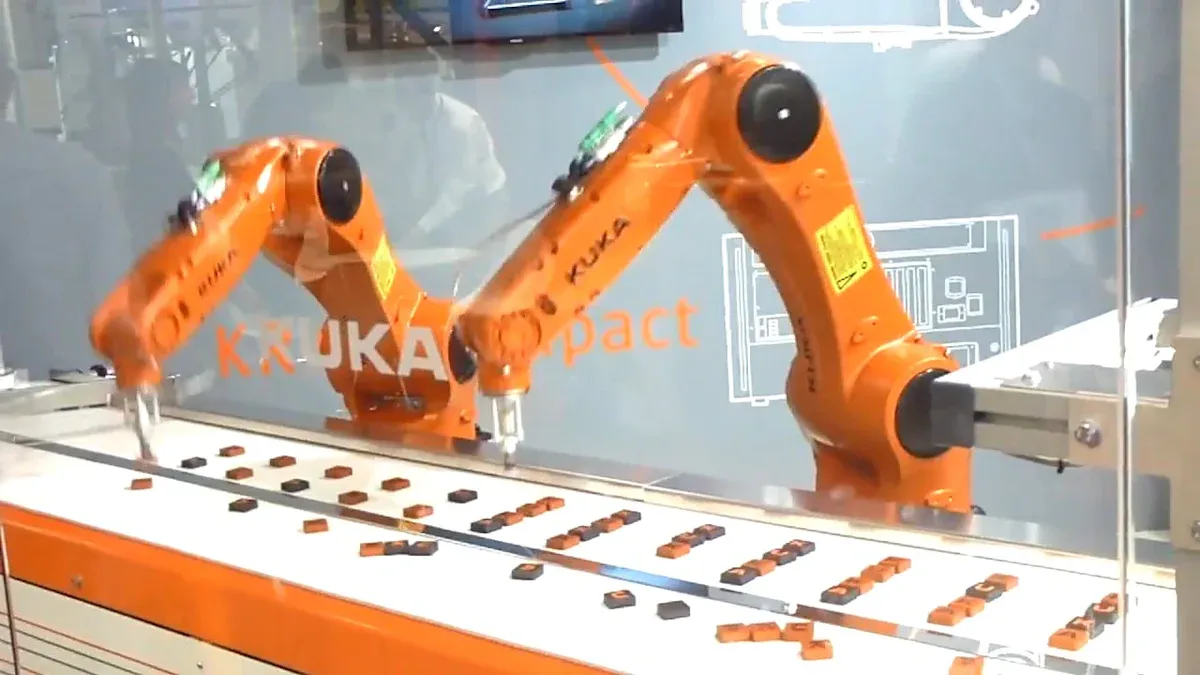
In 2025, rapid advancements in technology are transforming how machines process visual data. You might wonder why a random search machine vision system stands out in this evolution. Its ability to explore vast possibilities makes it crucial for enhancing machine vision systems. When modern systems face challenges like high complexity, a random search machine vision system offers a practical way to find effective solutions. By focusing on simplicity and adaptability, it helps refine tasks like object detection and pattern recognition. This approach supports learning in dynamic environments, ensuring that machine vision continues to meet real-world demands.
Key Takeaways
- Random search is a smart way to test many settings quickly.
- It works well for tough machine vision jobs like finding objects or splitting images.
- Random search fits both small and big systems, making it useful for many tasks.
- To get the best results, pick setting ranges using past info or tests.
- Mixing random search with other methods can make it work better and fix its weak points.
Understanding Random Search in Machine Vision
What is random search?
Random search is a simple yet powerful optimization technique. Instead of systematically testing every possible combination, it selects random values for parameters within a defined range. This approach allows you to explore a wide variety of possibilities without getting stuck in a specific pattern. In machine vision, random search helps you find the best settings for complex systems, such as neural networks or image processing pipelines. By focusing on randomness, it avoids the biases that can arise from more structured methods.
For example, imagine you are tuning a machine learning model for object detection. Random search lets you test different combinations of hyperparameters, like the number of filters or the size of pooling layers, to identify the configuration that delivers the best performance. This flexibility makes it a valuable tool in machine vision.
Key principles of random search in machine vision systems
To understand how random search works in machine vision, you need to focus on its core principles:
- Exploration over exploitation: Random search prioritizes exploring the entire parameter space rather than focusing on a specific region. This ensures that you do not miss potential solutions.
- Simplicity: Unlike more complex optimization methods, random search requires minimal setup. You only need to define the range of hyperparameters to test.
- Scalability: Random search adapts well to both small and large-scale machine vision systems. Whether you are optimizing a simple image classifier or a deep learning model, it can handle the task effectively.
- Robustness: Random search performs well even in noisy environments. It can handle uncertainty in data, making it suitable for real-world applications.
These principles make random search a practical choice for optimizing machine vision systems, especially when dealing with high-dimensional parameter spaces.
Comparison with other optimization methods
When comparing random search to other optimization techniques, such as grid search or Bayesian optimization, you notice distinct advantages and trade-offs. Grid search systematically tests all possible combinations of hyperparameters, but it becomes computationally expensive as the number of parameters increases. Bayesian optimization uses probabilistic models to predict the best parameters, but it requires more time to set up and may not scale well for very large systems.
The following table highlights some key differences in hyperparameter optimization for machine vision models:
| Model Type | Residual Blocks | Filters | Pooling Layers | RMSE | SSIM |
|---|---|---|---|---|---|
| ResNet | 4 | 68 | N/A | N/A | N/A |
| U-Net | N/A | 82 | 2 | N/A | N/A |
| Visually Preferred U-Net | N/A | 27 | 6 | N/A | N/A |
Random search stands out because it balances simplicity and effectiveness. It does not require exhaustive testing like grid search or complex modeling like Bayesian optimization. Instead, it focuses on quickly identifying configurations that improve accuracy and performance. This makes it particularly useful for machine vision tasks where time and computational resources are limited.
Advantages of Random Search in Machine Vision Systems
Efficiency in exploring large parameter spaces
Random search excels at exploring large parameter spaces with remarkable efficiency. It avoids the pitfalls of systematic methods like grid search, which can become computationally expensive. Instead, it samples hyperparameters randomly, ensuring a broader and more diverse exploration of the search space. This approach reduces the risk of getting stuck in local optima, which is critical for optimizing complex machine vision models.
- Random search effectively handles high-dimensional parameter spaces.
- It requires fewer computational resources, making it ideal for machine vision tasks.
- It uncovers unexpected, high-performing hyperparameter combinations that structured methods might miss.
Research by James Bergstra and Yoshua Bengio highlights that random search often requires fewer trials than grid search to find high-performing configurations. This makes it a time-saving and resource-efficient choice for machine vision systems.
Flexibility in diverse machine vision applications
Random search offers unmatched flexibility in adapting to various machine vision applications. Its probabilistic sampling allows you to incorporate prior knowledge about hyperparameters, enabling better exploration of hyperparameter space. This adaptability is crucial for tasks like object detection, image segmentation, and feature extraction.
| Aspect of Flexibility | Description |
|---|---|
| Probabilistic Sampling | Allows for sampling from parameter distributions, enabling prior knowledge. |
| Exploration of Hyperparameters | Facilitates better exploration in high-dimensional spaces. |
| Avoiding Rigid Constraints | Samples informative regions of hyperparameter space, avoiding grid limitations. |
This flexibility ensures that random search can optimize models for diverse machine vision challenges, from simple classifiers to advanced neural networks.
Robustness in handling uncertainty and noise
Machine vision systems often encounter noisy data and uncertain environments. Random search proves robust in such scenarios by abstracting noisy data and focusing on generalization. Studies show that models trained with abstracted data maintain high accuracy while improving noise robustness. This makes random search a reliable choice for real-world machine vision applications.
For example, in binary classification tasks, random search helps mitigate noise-related issues. It enhances the model’s performance by enabling better exploration of hyperparameter space, ensuring that the system adapts to varying conditions effectively.
By combining efficiency, flexibility, and robustness, random search continues to drive advancements in machine vision systems, making it a valuable tool for optimizing performance in 2025.
Limitations of Random Search in Machine Vision
Computational challenges in large-scale systems
Random search, while efficient, can face computational challenges when applied to large-scale machine vision systems. As the number of hyperparameters increases, the search space grows exponentially. This makes it harder to explore all possible combinations effectively. For example, optimizing a deep learning model with hundreds of hyperparameters can require significant computational resources. You might find that even with random sampling, the process becomes time-consuming and resource-intensive.
To address this, you can limit the range of hyperparameters or focus on the most impactful ones. However, this approach may reduce the diversity of the search, potentially missing optimal configurations. Despite its simplicity, random search may struggle to scale efficiently in highly complex machine vision tasks.
Risk of inconsistent results in certain scenarios
Random search relies on probabilistic sampling, which introduces an element of unpredictability. This can lead to inconsistent results, especially when the number of trials is limited. For instance, if you run random search multiple times on the same machine vision model, you might observe variations in performance. These inconsistencies can make it challenging to replicate results or ensure reliability in critical applications.
You can mitigate this risk by increasing the number of trials or using techniques like seeding to control randomness. However, these solutions may increase computational costs or limit the flexibility of the search process.
Importance of parameter tuning for optimal performance
The effectiveness of random search heavily depends on how you define the ranges and distributions of hyperparameters. Poorly chosen ranges can lead to suboptimal results, even if the search explores a large space. For example, studies have shown that fine-tuning hyperparameters can significantly improve model accuracy and reduce errors. In one case, hyperparameter tuning increased accuracy by 0.4%, while another study reported a 6.73% error reduction after gathering more data and refining features.
To achieve optimal performance, you need to carefully select hyperparameter ranges based on prior knowledge or experimental data. This ensures that random search focuses on the most promising areas of the search space, maximizing its effectiveness.
While random search offers simplicity and flexibility, its limitations highlight the importance of balancing computational efficiency, consistency, and thoughtful parameter tuning.
Applications of Random Search in Machine Vision

Hyperparameter optimization in machine learning models
Random search plays a vital role in hyperparameter optimization for machine learning models. When you train a machine learning model, selecting the best parameters can significantly impact its performance. Random search simplifies this process by exploring the hyperparameter space efficiently. Instead of testing every combination, it samples random configurations, saving time and computational resources.
For example, when tuning a random forest classifier, you might need to adjust parameters like the number of trees or the maximum depth. Randomizedsearchcv, a popular tool in scikit-learn, allows you to automate this process. By using random search, you can identify the optimal parameters that maximize model performance without exhaustive testing.
Studies by Bergstra and Bengio highlight the effectiveness of random search in hyperparameter tuning. Their research shows that random search often outperforms grid search, especially in high-dimensional spaces. It explores a broader range of configurations, leading to better model performance on tasks like image classification and object detection. This makes random search an essential tool for improving test accuracy and achieving superior results in machine learning.
Enhancing object detection and recognition systems
Object detection and recognition systems rely on precise parameter settings to achieve high accuracy. Random search helps you fine-tune these systems by optimizing hyperparameters like learning rates, filter sizes, and activation functions. This ensures that your model adapts to diverse datasets and performs well in real-world scenarios.
For instance, when training a convolutional neural network (CNN) for object detection, you can use random search to find the best parameters for layers and filters. Randomizedsearchcv in scikit-learn simplifies this process, allowing you to focus on improving the model’s accuracy. By leveraging random search, you can enhance the system’s ability to detect objects in noisy or complex environments.
In addition, random search proves effective in optimizing machine learning algorithms for feature extraction and image segmentation. Its flexibility allows you to explore different configurations, ensuring that your system achieves optimal performance. Whether you’re working on facial recognition or autonomous vehicle systems, random search provides a reliable method for improving detection and recognition capabilities.
Real-world use cases and success stories
Random search has demonstrated its value in various real-world applications. For example, companies use it to optimize hyperparameters in machine vision systems for quality control in manufacturing. By fine-tuning parameters, these systems can detect defects in products with high precision, reducing waste and improving efficiency.
Another success story involves the use of random search in medical imaging. Researchers have applied it to optimize models for detecting diseases in X-rays and MRIs. By identifying the best parameters, they have improved the accuracy of these systems, enabling faster and more reliable diagnoses.
In the field of autonomous vehicles, random search has been instrumental in enhancing object detection systems. By optimizing hyperparameters, developers have improved the ability of these systems to identify pedestrians, vehicles, and road signs in real time. This has contributed to safer and more efficient self-driving technologies.
Random search also finds applications in agriculture, where it helps optimize machine vision systems for crop monitoring. By fine-tuning parameters, these systems can identify plant health issues and recommend targeted interventions. This improves yield and reduces the environmental impact of farming practices.
These examples showcase the versatility and effectiveness of random search in solving real-world challenges. By leveraging its capabilities, you can unlock the full potential of machine vision systems and drive innovation across industries.
Trends in Random Search for Machine Vision in 2025

Integration with AI and deep learning advancements
In 2025, the integration of random search with AI and deep learning has reached new heights. You can now use random search to optimize hyperparameters in deep learning models more effectively. This technique allows you to explore vast parameter spaces, ensuring that your model achieves peak performance. For instance, random search can help fine-tune neural network architectures by adjusting the number of layers, activation functions, or learning rates.
Deep learning frameworks like TensorFlow and PyTorch have incorporated random search tools, making it easier for you to implement this method. These tools enable faster experimentation, helping you identify configurations that improve model accuracy. By leveraging random search, you can enhance the adaptability of AI systems, ensuring they perform well across diverse datasets and tasks.
Hybrid approaches combining random search with other techniques
Hybrid approaches are transforming how you optimize machine vision systems. By combining random search with other methods, such as Bayesian optimization or adaptive strategies, you can overcome the limitations of standalone random search. These hybrid techniques start with random search for broad exploration and then refine the search using more targeted methods.
Empirical studies show that hybrid methods significantly outperform traditional approaches like grid search. For example:
| Challenges of Random Search | Advantages of Hybrid Approaches |
|---|---|
| Inconsistent performance due to stochastic nature | Combines strengths of multiple methods for better results |
| Fails to capture complex parameter interactions | Starts with random search for exploration, then refines with Bayesian optimization |
| Misses critical parameter combinations | Empirical studies show advanced techniques outperform random search |
Additionally:
- Adaptive and Monte Carlo methods excel in high-dimensional search landscapes.
- Combining uniform sampling with adaptive strategies often leads to superior outcomes.
These hybrid approaches ensure that your machine vision models achieve optimal performance while reducing computational costs.
Innovations in hardware and software for faster optimization
Advancements in hardware and software are accelerating random search optimization. Modern GPUs and TPUs now support faster computations, enabling you to run more trials in less time. Specialized hardware accelerators designed for machine learning further enhance the efficiency of random search.
On the software side, new algorithms and libraries streamline the random search process. Tools like Optuna and Hyperopt offer advanced features, such as dynamic sampling and early stopping, which save time and resources. These innovations allow you to focus on improving your model rather than managing computational overhead.
By combining cutting-edge hardware with intelligent software, you can optimize hyperparameters more efficiently. This ensures that your machine vision systems remain competitive in an ever-evolving technological landscape.
Random search plays a vital role in advancing machine vision systems. It empowers you to explore vast parameter spaces efficiently, adapt to diverse applications, and handle uncertainty with ease. While it offers simplicity and flexibility, you must address its computational challenges and ensure proper parameter tuning for optimal results.
Key Takeaway: Random search balances efficiency and adaptability, making it a powerful tool for solving real-world machine vision problems.
By embracing random search, you can unlock innovative solutions and stay ahead in the evolving field of machine vision.
FAQ
What makes random search different from grid search?
Random search explores parameter spaces by sampling randomly, while grid search tests every possible combination systematically. Random search is faster and more efficient for high-dimensional spaces. It helps you find good solutions without testing every option, saving time and computational resources.
Can random search work with deep learning models?
Yes, random search works well with deep learning models. It helps you optimize hyperparameters like learning rates, layer sizes, and activation functions. By exploring diverse configurations, you can improve your model’s accuracy and performance without exhaustive testing.
How do you handle randomness in random search?
You can control randomness by setting a seed value. This ensures reproducibility, allowing you to get consistent results across multiple runs. Tools like random.seed() in Python make this process simple and effective.
Is random search suitable for real-time applications?
Yes, random search is suitable for real-time applications. Its efficiency allows you to optimize parameters quickly, making it ideal for tasks like object detection in autonomous vehicles or quality control in manufacturing.
What tools can you use for random search?
You can use tools like RandomizedSearchCV in scikit-learn, Optuna, or Hyperopt. These libraries simplify the process of implementing random search, offering features like dynamic sampling and early stopping to save time and resources.
Tip: Start with a smaller search space to test your setup before scaling up.
See Also
Future Trends in Segmentation for Machine Vision Systems
Understanding Regions of Interest in Machine Vision Technology
Field of View Considerations for Machine Vision Systems
Defining Edge AI for Real-Time Machine Vision Applications
Fundamentals of Sorting Systems in Machine Vision Technology








